A New Marketing Playbook for the Age of Zero-Click Search
What’s a marketer to do when people don’t find their way to your website as they’re researching solutions to their pain points?
The fact is, people don’t click through to web pages from search results like they used to. For the past few years, an increasing percentage of searches are “zero-click” experiences. Those top-of-funnel (ToFu) audiences simply aren’t landing on your site’s content pages like they used to. However, the issue has gained momentum over the past year, amid the rise of AI-search.
Since May 2024, Google has aggressively rolled out AI Overviews (AIOs), which draw information from the web to answer user queries directly, often even when people aren’t overtly choosing to use an AI answer engine. Now, a year later, Google’s AI Mode is live for US audiences and is seeing staged rollouts in other markets. And beyond Google, buyers are also increasingly turning to LLMs like ChatGPT, Perplexity, Claude, Grok and Copilot for clear summaries.
As a result, zero-click search has skyrocketed. Even clickthroughs to top-ranking pages for informational queries are extremely rare nowadays, according to data from Ahrefs.
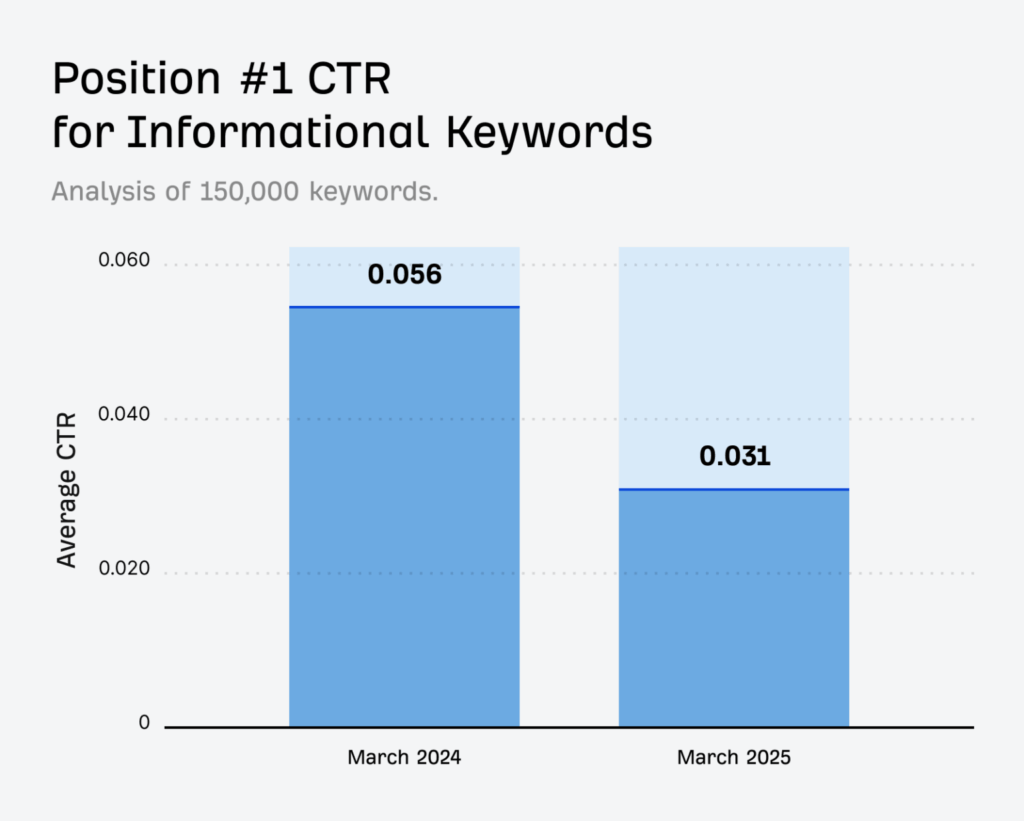
The entire premise that driving traffic to your website as the start of the buyer’s journey has been rocked to its foundations. As marketers, we need to contend with a whole new reality that calls for a whole new model of audience acquisition and content-driven nurture flows.
A Completely Decentralized Buyer’s Journey
Today, more and more of the buyer’s journey takes place before you have any way of knowing about it, let alone engineering it.
In the B2B tech space, potential buyers rule brands in or out before they even compile their shortlists, often without checking out any vendor’s website. People are generally skeptical about what brands have to say about themselves, so buyer committees prefer to rely on their own past experiences, or on crowdsourced knowledge from AI chatbots, niche influencer-created product reviews, ratings sites like G2 and Gartner Peer Insights, and community discussion platforms like Reddit or Quora.
Instead of publishing content on earned, owned and shared media properties for the purpose of driving low-intent traffic to your site, now it’s all about optimizing those presences so you’re recommended as a valuable solution with trust and authority.
Whether it’s measurably true or not, decades’ worth of content marketing strategies were built on the premise that the vast majority of businesses aren’t actively looking to procure solutions, so it’s best to build an audience you can nurture over time, and the conversions will come eventually.
If that’s how your company’s funnel is conceived, then much of it will still be useful, but you’ll need to rethink where the low-intent, trust-building takes place and how to surface resources that encourage it.
High-Intent Homepage Arrivals
The same nurture process that used to take place on your website is now carried out off-site, before leads arrive, so that’s where you need to focus your optimization efforts. Recent data shows that while overall organic search traffic has dropped since the rollout of AIOs, there’s been a rise in clicks direct to the homepage, which makes brand search traffic a potent proxy metric for marketing success.
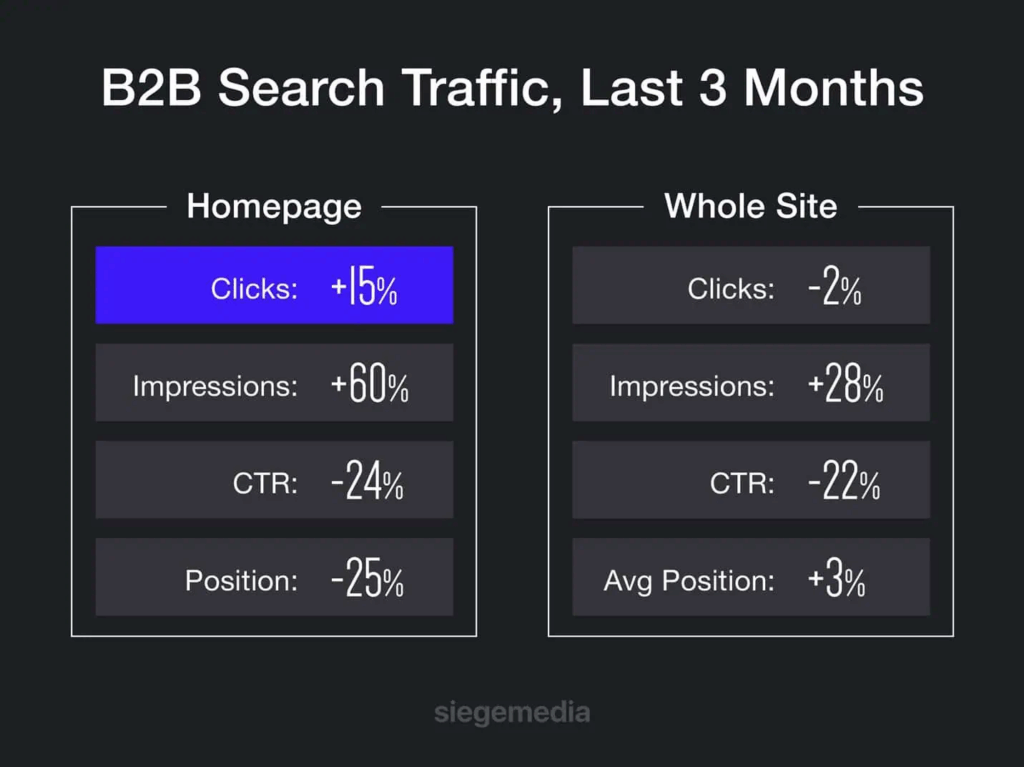
That’s because if leads are coming straight to your homepage, it indicates that they know your brand name and trust it enough to seek it out in a crowded market.
The visitor who actively looks for your brand may have even researched several solutions via extended conversations with an LLM. They’ve looked at reviews of your product, scoured discussion threads comparing several vendors in your category, and might have even checked out your take on the industry via your thought leadership assets in trade blogs and podcast interviews – all of which surfaced in their AI conversations.
This new breed of homepage visitor is more likely to buy than someone who was taken to your site from a low-intent keyword search, so that today, brand search traffic is more likely to lead to conversions.
In a recent rant about the zero-click reality we’re in, digital marketing thought leader Rand Fishkin makes the bold claim that “traffic was always a vanity metric – sales are what really matter.” That’s 100% true from a big-picture business growth perspective, but from a marketing strategy perspective, it’s an oversimplification.

Sure, a lot of low-intent search traffic was always meaningless, but that’s why B2B marketers always talked about funnel drop-off points, weeding out irrelevant audience members along the way so that by the end of the journey, marketing-qualified leads were handed off to sales, ready to close.
Today we need new strategies to augment the old low-intent keyword-based SEO-centric approaches we’ve been relying on. You want to publish and distribute content in a way that’s optimized for new search habits, aiming to master generative engine optimization (GEO) – which calls for a whole new playbook.
Search Everywhere Requires Awareness Everywhere
Those SEO tactics of yesteryear aren’t as effective as they once were. For example, keyword-optimized backlinks don’t impress AI search engines. Now you need to optimize your content to drive mentions where people are looking for information – whether that’s on AIOs, AI chatbots, community platforms, or even Google answer boxes, it involves a number of tactics.
“SEOs have to change from doers to influencers now. They have to educate and evangelize vs. pressing buttons,” says Patrick Reinhart, a VP at Conductor. “There’s nothing wrong with understanding where you’re ranking and what you’re ranking for; it just shouldn’t be the only thing you’re relying on. Keywords should be an adjacent metric that helps give you an overall idea of brand visibility and where you’re appearing.”
It’s a bit of a “serpent eating its own tail” moment, but cutting-edge AI is driving a renewed need for old-fashioned PR. Today, earned media is less about driving search rankings and more about teaching LLMs that your brand is worthy of being recommended when people ask questions that are relevant to your solution. And that’s where contextually relevant PR brand mentions shine, especially when they’re optimized in format and voice to be noticed by AI models and their agents.
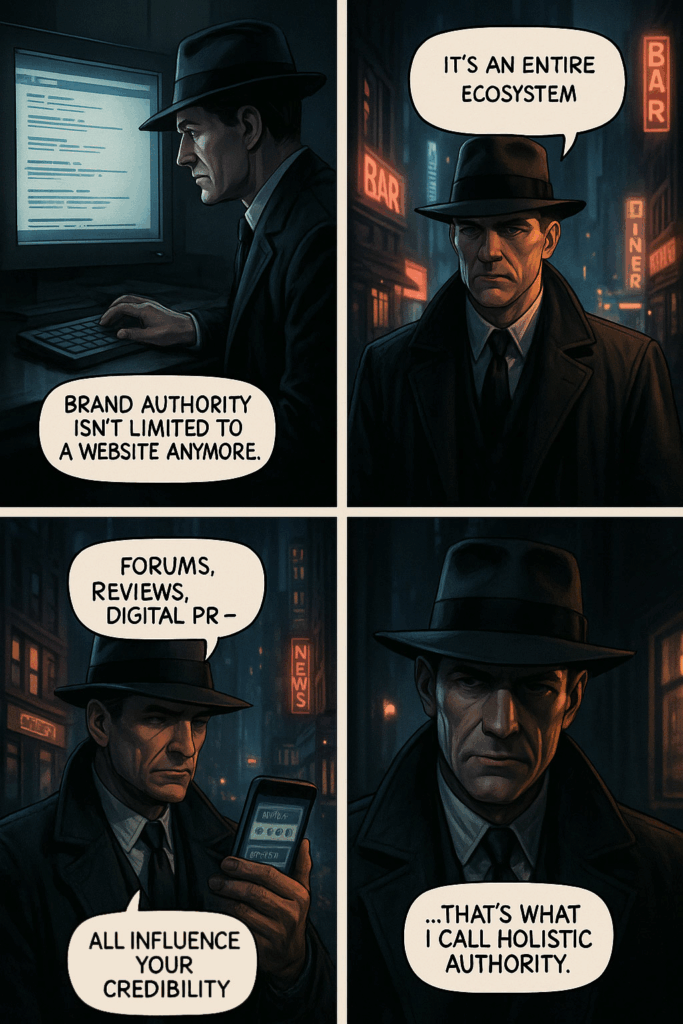
Ultimately, every mention in LLM summaries and other platforms drive brand visibility, awareness, and trust, keeping your brand top of mind. When customers are aware of you and trust your brand, they’ll head to your homepage as soon as they’re ready to buy.
So if people aren’t clicking through to your website anymore from those blue links associated with top-of-funnel keywords, is it even possible to recover that traffic? And do you really need so much low-intent traffic anyway? Here are some things to consider and tactics to experiment with.
1. Give Bots (and People) Total Content Access
For a long time, marketers argued about the benefits and drawbacks of gated content. Is it a smart way to harvest email addresses, or a self-defeating way to stop prospects from discovering and accessing your best content?
The debate ran on for years, but in the AI search era, gates are clearly a bad idea. If your industry research and top thought leadership items are stuck behind an opt-in form, AI robots won’t reach them. You need to make sure that all your content is crawlable.
Google’s crawlers miss about 50% of the pages on a large website, so you should also reassess your site structure. The deep indices that were preferred to build site authority are an obstacle to AI crawlers. Make sure your robots.txt file is set to welcome AI engines’ crawlers, and focus your earned media efforts on publications that do the same.
LLMs.txt is a potentially potent tool here, too. It’s an often-overlooked but significant markdown file that draws AI attention to specific URLs that contain your best, most LLM-friendly content, with explanations of the purpose of each key page.
2. Diversify Your Content Formats
Traditionally, PR coverage of B2B brands has consisted of expert quotes and company or product use case mentions in articles, with some bylined thought leadership opinion pieces and interview feature articles in the mix. AI takes notice of these presences, especially if the articles appear in authoritative, niche-specific publications.
But if you’re exclusively focused on articles, it could be time to branch out. AI engines often cite sources from multimedia content, with YouTube serving as a popular source of information for some LLMs and podcasts influencing others.
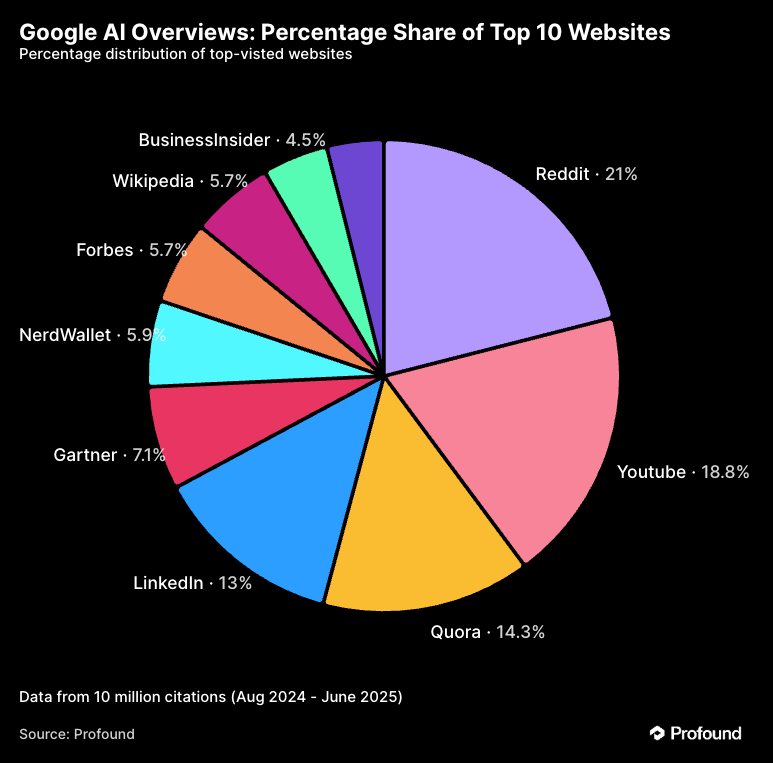
What’s more, Google aggregates video thumbnails on search results pages, and rich media draws far more clickthroughs than blue text links.
TeamOhana’s Nikiya Griffith advises that “You’re more likely to appear in featured snippets and rich results if you go beyond traditional articles. High-quality videos and other engaging formats can help ensure your content reaches its audience in new ways.”
3. Respect AI’s Content Style and Structure Preferences
AI search citations favor data-driven deep dives, structured information and declarative voices. Research-based long-form blog posts, how-to guides, comparison pieces and non-salesy thought leadership pieces are more likely to be considered authority sources by the leading LLMs.
AI engines can process and summarize information more easily from ordered lists, definitions, charts, bullet sections and FAQs, and they like content that answers real questions that users ask.
Schema markup and literal, transparent section titles can also go a long way, both for your content to surface in AI search and to increase the chances that your content will appear in answer boxes, knowledge panels and other “features” in traditional Google search. While this might not result in more clickthroughs from the search results, it certainly increases your visibility.
You’ll need to bear this in mind when you write your own content, but also when you look for experts to help you land more earned media mentions. It’s important to work with PR pros who know how to select the right publications for GEO success, and can work with contacts at those publications to maximize GEO impact.
4. Adjust for AI’s Authority Signals
Off-site earned authority and mentions in social media conversations and reviews are crucial to boost authority for AI rankings. Over 90% of the content cited in AI-powered responses to non-branded queries comes from third-party sources, and over 60% for branded queries.
You want to optimize for discovery everywhere, on social media, podcasts, discussion forums and more. AI search engines appreciate Reddit discussions, with Reddit citations in Perplexity results having recently jumped fortyfold.
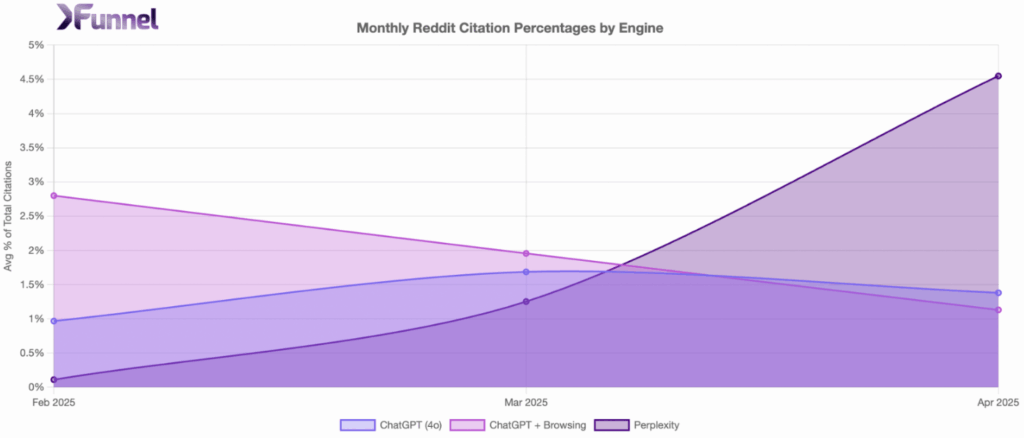
What’s more, Google’s partnership with Reddit means that the platform is among the most cited in Gemini answers, and even traditional search has new ways of prominently aggregating Reddit content.
Studies have also shown that AI engines favor fresh content and high volumes of mentions, including those in community-driven platforms like LinkedIn, X, Quora and Medium. Frequent mentions build context for how AI maps the significance of your brand, so think of this as the legwork that gets your brand mentioned more often by AI summaries – and gets your content featured more frequently in traditional search result features.
5. Consider Paid Ads
Of course, you should be thinking about creating content that surfaces organically across platforms so people can learn about you before they reach your website. All the better if your earned media efforts manage to influence the AI summaries and overviews that are shown when people perform searches related to your space.
But if you already have a successfully humming funnel that relies on a steady stream of ToFu traffic, you might want to try feeding it through increased paid search ads. Once you’ve captured your leads, you’ll need to continue to nurture them through email and retargeting ads, but that’s a familiar process.
If your lead funnel relies heavily on website visitors and organic rankings aren’t directing the traffic you need, you can buy the clicks instead, especially for ToFu keywords. It might not be the most cost-effective or future-proof strategy, but it can buy you time, feeding the dealflow pipeline while you figure out new ways to build visibility in today’s zero-click reality.
It’s also worth noting that there are strong signals indicating paid ads are headed to AI search engines, even though OpenAI’s Sam Altman previously said that he hates ads.
Don’t Be Afraid of Zero-Click Search
The meteoric rise of zero-click search has unsettled the entire marketing world, but there’s no need to panic. Brand-building is still vital, and search visibility is even more critical for driving trust and sales.
You may even be able to recover some of that top-of-funnel traffic, although it’s probably best to also shift gears – you’ll need a new strategy which takes advantage of the ways that AI understands authority and empowers leads to nurture themselves before they reach your website.
